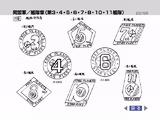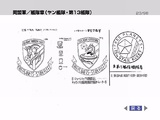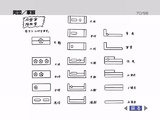Free Planets Star Fleet
From Gineipaedia, the Legend of Galactic Heroes wiki
The Free Planets Star Fleet (Japanese: 自由惑星同盟軍宇宙艦隊), also known as the Alliance Fleet and the Rebel Fleet (to its adversaries), was the main military arm of the Free Planets Alliance, and the direct adversary of the Imperial Fleet during the Alliance–Imperial War.
Contents |
History
Establishment
The Free Planets Star Fleet was founded very early in the Alliance's days by the members of the Exodus Fleet, who were quite aware, from personal experiences, of the fact that the Galactic Empire would in all probability try to conquer the young republic. The original settlers, having through necessity and hardship learned to build and maintain ships very efficiently, built the original Alliance Backbone Fleet, and started building up their shipbuilding capacities. The founders were very adamant in their warnings to future generations, and subsequent generations continued to build up a military force, while its soldiers stood ready to defend the nation at any given moment.
Early days
For over a century, peace and growth generally flowed through the Alliance as its population and industry rose by leaps and bounds. As did the nation, so did the fleet. Construction of great military shipyards was completed around Heinessen and around the Ba‘alat Starzone, allowing it to grow from the handful of dedicated warships built a century ago to a force of 25,000 destroyers, cruisers and battleships by the time the Alliance and Empire finally made contact. Although there is evidence that the Star Fleet was very active before 640 UC (331 IC / 3440 CE), and maintained bases in several Alliance systems, its role seemed to be little more than a peacekeeping force.
Alliance–Imperial War: Early phase
In February of 640 UC (331 IC / 3440 CE), the Alliance and the Empire finally made contact, and the result was exactly what the Alliance's founders had feared: the Empire immediately assembled a fleet to conquer what they saw as a rebel group. In response, the Alliance mustered its carefully built Star Fleet. Led by geniuses Lin Pao and Yusuf Topparol, the smaller space force decisively crushed its Imperial counterpart in the Battle of Dagon, setting the stage for sixteen decades of on-again, off-again warfare.
By fighting almost exclusively defensively, the Star Fleet negated the greater numbers that the Reichflotte consistently enjoyed, allowing it to maintain a rather constant strategic stalemate, while tactical victories and defeats were given to both sides in rather equal measures. In fact, due to its lesser numbers, the Alliance worked to maintain the war to the tactical level.
Bruce Ashbey and the 730 Mafia
The Star Fleet would reach the peak of its power under the Alliance group called the Year 730 Mafia, led by the flamboyant Alliance genius Bruce Ashbey. As a talented group of young officers who had been friends since their academy days and had graduated together — hence the name of their group — they rose quickly through the ranks, becoming increasingly important in the Star Fleet until, by 745 UC (436 IC / 3545 CE), Ashbey was Space Fleet Commander and five of the numbered fleets were under the command of a separate member of the Mafia. During the 740s, this powerful group struck hard against Imperial forces, inflicting many defeats upon the Empire, culminating in the very lopsided victory at the Second Battle of Tiamat in 745 UC (436 IC / 3545 CE).
That battle, however, saw the death of Bruce Ashbey, and with none of the others having the sheer charisma to lead the group, it disbanded. Nevertheless, its members remaining in the military during the 740s, 750s and 760s allowed the Star Fleet to retain a certain advantage in terms of talent. This talent, however, did not prevent the Empire from ultimately claiming much of the Iserlohn Corridor by building Iserlohn Fortress. Thus, while it could be said that the Alliance maintained a tactical edge for many years, it was losing on the strategic field.
Decline and defeat
After the 730 Mafia departed, the Star Fleet's command staff and its general tactical prowess declined and stagnated, and by the 790s, few of the admirals in general command of the Fleet could boast to having command talent truly above the ordinary. This stagnation proved disastrous when confronted with the rising power of the Imperial genius, Reinhard von Lohengramm, who built up an increasing following. The corruption and stagnation in the Star Fleet was in fact such that the only man who would prove himself a match for Lohengramm, Yang Wen-li, would be hindered far more than helped in his efforts to prevent the Imperials from achieving success.
Following the decisive Imperial victory at the Battle of Astarte, the Alliance and its fleet enjoyed a brief resurgence of power through the aforementionned Yang and his newly formed 13th Fleet, who took Iserlohn in the Seventh Battle of Iserlohn. This advantage was wasted when the bulk of the Star Fleet was then sent in an ill-prepared invasion of Imperial territory, where it was mostly wiped out by Lohengramm's careful, if ruthless, strategy. Immediately afterwards, the Alliance Civil War further reduced the Star Fleet's strength, so much that it could no longer stand up to Imperial invasion.
Despite Yang Wen-li's victory at the Eighth Battle of Iserlohn, the fleet was unable to meet the challenge of Lohengramm's large-scale Operation Ragnarök in UC 798. Despite the efforts of Fleet Admiral Alexandre Bewcock at the Battle of Rantemario, and Yang Wen-li's successful guerilla campaign, the Alliance surrendered just as the Battle of Vermilion, a clear Alliance victory in the making, was reaching its final phase. Standing down, the fleet was then slated to be slowly scrapped per the Treaty of Ba‘alat in 799 UC (1 NIC / 490 IC / 3599 CE).
Dissolution
The Star Fleet, fatally diminished, would splinter after the end of the war, with many eventually following Yang Wen-li's fame and genius, forming a resistance group. The remaining Alliance-aligned fleet, however, would rally one final time when Reinhard von Lohengramm, by then the first Kaiser of a new Imperial dynasty, decided to fully absorb the Alliance. Mustering a fleet of 20,000 ships, Fleet Admiral Bewcock and the Star Fleet fought a brave but doomed battle at the Battle of Mar-Adetta, where the Star Fleet ceased to exist as an Alliance force. The survivors of this battle linked up with Yang Wen-li's forces.
With the dissolution of the Alliance in February 800 UC (2 NIC / 491 IC / 3600 CE), ironically exactly 160 years after the initial Alliance-Empire contact, the Free Planets Star Fleet officially ceased to exist.
Size and Organisation
Early Years
The legal predecessor and initial Alliance spacy, the Alliance Backbone Fleet, was very small, consisting of eight battleships and presumably a smattering of smaller military craft. As the 'battleships' were effectively little more than souped-up cruisers, its effective power was initially very small. It was presumably only used to protect the small, if fast-growing, republican colony of Heinessen, and was likely only built as a psychological element of reassurance against the ever-present fear of Imperial invasion felt by the original settlers. The organization of this early force is unknown, but it is known that it continued to expand over the years.
Battle of Dagon Era
A century later, diligent and exponential fleet-building had produced a force of 25,000 warships, divided between battleships, cruisers and destroyers. Given the small size of the Alliance at the time, the number of active warships pre-640 was almost certainly much smaller than its total numbers, as the Alliance had never needed such power for the first 113 years of its existence. It can be presumed that most of the enlisted men in the Dagon fleet, and perhaps a fair fraction of its officers, were reservists.
The Battle of Dagon saw the formation of several concepts which would remain throughout the war. The fleet was divided into independent commands, with a Vice Admiral commanding each separate fleet, and the present Alliance uniform was said to have been first used during the battle - although such a claim was ever since debated by historians. The Star Fleet thus divided into six independent fleets of roughly 4,000 to 4,500 ships. Although numbered fleets did not exist during the initial battle, it can be presumed that those independent forces eventually evolved into them.
Second Battle of Tiamat Era
Over a century of off-and-on warfare greatly increased the power of the Star Fleet. By the Second Battle of Tiamat, more efficient types of warships were the norm, and numbered fleets were now long established. Moreover, dedicated flagships existed as each fleet's mobile headquarters.
By this time, the Star Fleet was composed of eleven numbered fleets, and could also muster an equivalent 'Headquarters' fleet for especially large engagements. As the full-strength fleet of the time was 8,000 warships, the Star Fleet had a total fleet strength of 96,000 warships at the very least. 48,000 ships was, at that point, the largest force that the Alliance could muster in one area without presumably endangering its overall defenses.
Battle of Astarte Era
Fifty years after the Second Battle of Tiamat, the Star Fleet had grown even further. By this time, it had grown to twelve numbered fleets, each of them able to call upon roughly 13,000 ships at full strength, with several reserve forces being on hand for special operations as the HQ Fleet. Before Astarte itself, the strength of the Star Fleet could thus be calculated at roughly 170,000 warships, which would be its peak, numbers-wise. The largest muster up to Astarte was the Fifth Iserlohn Offensive Fleet, numbering over 50,000 ships.
The situation was generally the same as the one existing during Second Tiamat, with one, significant exception: battles now utilized carriers and large amounts of space fighters. The current, mainstream Alliance fighter, the Spartanian, would engage in fleet engagements for over thirty years, right up to the war's end and beyond.
Ship Design
From the very first day, the Alliance founders were quite aware that, even with the government-sponsored population explosion, the Free Planets Alliance would be far smaller and have fewer resources to draw upon on the day contact would be made with the Galactic Empire. Assuming the worst, that the Empire they would encounter would be much like the one they had left, they remained firmly convinced that a powerful fleet would have to be built, large enough and powerful enough to counter the Imperial forces effectively.
Fortunately, an efficient force had been built in a similar situation centuries ago: the Black Flag Fleet. Presumably working with old Black Flag ship designs, Alliance technicians resolved to build simple, spartan ships which would be nearly devoid of anything unnecessary. The warships of the Free Planets Star Fleet would be created solely for the purpose of fighting.
Throughout Alliance history, the ships have followed a simple, increasingly modular design based on a long, rectangular shape. One end would be a single, powerful engine, followed by the engineering section and propellant storage. After the propellant storage would be the living quarters and bridge, the armoured hull peppered here and there by sensors, defensive cannons, and communication equipment. The front part of the ships would be devoted to the ship's main cannons. These would be built to be as independent from each other as possible to maintain firepower in case of damage. Early on the Alliance chose to focus on rate of fire so Alliance ships mounted larger numbers of smaller calibre main cannons than their Imperial counterparts. Although some designs would deviate from these basics, they would remain the main warship construction method throughout two and a half centuries of Alliance history.
Because of the need to spare resources and maximize ship production, Alliance ships were never outfitted with anti-gravity units, forcing crews to board the ship and supplies to be taken in by shuttles. The same design philosophy and lack of resources would make it so that Alliance ships, aside from the flagship classes, would generally be smaller than their Imperial counterparts.
In the end, Alliance ship design bore fruit: throughout the war, the Alliance forces proved themselves to be an even match for Imperial forces, making what should have been a short conquest into a war which would last sixteen decades.
Appendices
Name variations
- Free Planets Star Fleet (LD/DVD subtitles)
- 自由惑星同盟軍宇宙艦隊 (LD/DVD subtitles — Japanese)
Licensed sources
The Free Planets Star Fleet was formed shortly after the founding of the Alliance as the Alliance Backbone Fleet. Its core was initially composed of 8 newly constructed Heinessen class battleships, equivalent in size to cruisers of the Alliance's final days. The Heinessen class was followed by the greatly enlarged and expanded Nguyen Kim Hua class. Production capacity and speed was greatly increased with the building of orbital construction facilities above Heinessen. (Data Book: Mechanic & Seiyū Encyclopaedia, p. 109-110)
Apocrypha
DVD features
Production sketches for the uniforms and fleet patches of the Free Planets Star Fleet appear in the DVD features of the DVD box set




